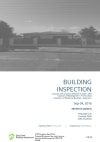Safe house Inspections
What is the purpose of a Safe house Report?
Every year, one-third of all accidents occur in the home and thousands of Australians are injured and hospitalised following home accidents. The residential home is second only to the road as the location of most accidental deaths in Australia.
If you are an occupier of a private property, you should exercise reasonable care to prevent any foreseeable risks to anyone who may come into your land or premises; this includes areas within and outside walls of your home. According to the Australian Bureau of Statistics, people who received injuries were most likely to experience them inside their own or someone else’s home.
Accidents involving guests at your home may be prevented if extra care is taken. Install adequate lighting around your home, especially near stairs and bathrooms. Your walkways and corridors should also be clutter-free. Sharp objects such as knives should be safely tucked away and your mirrors securely attached to the walls. Remember never to leave open flames such as lit stove tops unattended.
East Coast Building Inspections Safe house Reports expose safety hazards and help to provide the end-to-end services that remove them. This ensures your property, whether owned or managed, is safe for your loved ones and tenants.
Children & potential accidents around the house or unit:
- Each year, around 50 children fall from windows or balconies Australia wide, many suffer serious injuries sometimes these falls are fatal.
- Each year over 250 Australian children (ages0-14 years) are killed and 58,000 hospitalised by unintentional injuries- the kind often referred to as accidents.
- Many of these are easily prevented by simple means injury has take over the leading cause of fatalities in children under the age of 15 and more than half of all injuries occur at home.
The number of incidents that occur in and around the home is significant, children falling from windows, fire deaths and injuries, poorly maintained balconies or balustrades, and pool deaths. A clear majority of these and deaths could have been prevented.
In Australian homes each year:
- 350 children are killed by accidents
- Over 150,000 children visit hospital emergency rooms
- 38,000 children visit hospitals with crushes or glass cuts
- Over 5,000 children are hospitalised due to falls in their home
- 30 children drown at home
- 2,000 children are hospitalised due to poisoning
- 1,000 children are hospitalised due to burns
- 1,500 children are hospitalised following finger jams (many resulting in amputation)
Most common emergencies for babies & toddlers:
- Choking
- Drownings
- Burns & Scalds
- Cuts & Bruises
- Febrile convulsions
- Unconscious or not breathing
- Breathing difficulties, such as asthma & croup
Most common causes of childhood injuries:
- Falls
- Drownings
- Road accidents, such as running into traffic
- Poisoning
- Burns & Scalds
The most common place for young children to be injured is in their own home. As children get older, injuries in community settings such as playgrounds, sports fields, at school and on our roads become more common. Ensuring the safety of our homes, roads & communities is paramount for keeping children safe.
Adult accidents around the house or unit:
Falls burns & brain injuries are a common but often overlooked, cause of injury. Around one in three adults over 65 who live at home will have at least one fall a year, and about half of all these will have more frequent falls.
Most falls don’t result in serious injury. However, there is always a risk that a fall could lead to broken bones, and it can cause the person to lose confidence, become withdrawn and feel as if they have lost their independence.
What can happen after a fall?
- Falls can cause broken bones, like wrist, arm, ankle & hip fractures
- Falls can cause head injuries. These can be very serious, especially if the person is taking certain medicines ( like blood thinners)
- An older person who falls and hits their head should see their doctor right away to make sure they don’t have a brain injury.
- Many people who fall, even if they are not injured, become afraid of falling. This fear may cause a person to cut down on their everyday activities. When a person is less active, they become weaker and this increases their chances of falling.
What conditions make you more likely to fall?
- Lower body weakness
- Vision problems
- Foot pain or poor footwear
- Home hazards or dangers such as, broken or uneven steps
- Throw rugs or clutter that can be tripped over
- Vitamin D deficiency (that is not enough vitamin D in your system)
- Difficulties with walking and balance
- Use of medicines, such as tranquilizers, sedatives, or antidepressants. Even some over-the-counter medicines can affect balance and how steady you are on your feet.
- 7 in 10 people ages 65 and over who were hospitalised with a fall related injury had fallen at home.
- Falls accounted for almost three-quarters of hospital admissions (73%)
- More than half of emergency department presentations were for injuries that occurred in the home (54%)
- People aged 65 years and over accounted for nearly 95% of the total fall-related deaths.
- More than one in three community dwelling people aged 65 years and over falling annually.
- Over 92,150 fall injuries involving people 65 years and over resulted in hospitalisation in 2010-2011.
East Coast Building Inspections Safe house provides homeowners, investors & real estates with significant risk management protection for their homes. Safe house reports identify all safety hazards & recommend actions that should be undertaken to meet Australian Standards & ensure a property is safe for the occupants. It includes specific property details, and executive summary with photos, and action lists.
The Reports:
- Identify potential risks within a property
- Deliver crucial protection to homeowners, landlords & property managers
- Provide recommended actions
- Provide a safer environment for family members & tenants
- Address all legally required compliance inspections
Contents of our reports:
- Building hazards & damage
- External balconies, decks & stairs
- Internal stairs & balustrades
- Window height hazards
- Curtain cord hazards
- Glass hazards
- Slip hazards
- Trip hazards
- Fall hazards
- Electrical hazards
- Electrical safety switch
- Gas hazards (Natural, Propane, Butane, LPG & LNG excludes C02)
- Smoke alarms & fire safety items
- Fireplace/fixed heater hazards
- Inhalation/Contaminant/Ingestion hazards
- Hot water hazards
- Ventilation
- Moisture hazards
- Pest hazards
- Tree/branch hazards
- Security hazards
- Safe pool
- Pool fencing & gates
- Personal observation
- Other general risk areas
Visit our pricing page for costs, or contact us for more information.



